I loved this Superorganizers interview with my friend, Josh Kaufman that dives into how Josh does research, reading, writing, and uses Ulysses. And how he has a separate computer that is only for doing focused work.
Writing
One of my favorite journaling prompts
“Today was a good day because…”
A few tips for intentional note taking →
Capture and organize things in such a way that you will be able to use those notes and ideas, not just feel good about having captured or organized them. Otherwise, just enjoy what you read and learn and keep on going.
Learn Ulysses →
I’ve had 3 different conversations with 3 different folks in the past 24 hours about how much they are loving Ulysses. It’s such a great app — I still do nearly all my writing in it. If you’ve got a writing / idea project in the works and you’re feeling scattered, you should definitely check out Ulysses and let me show you exactly how to use it.
How to Get the Most Out of a One-Day Writing Escape →
Some great advice from Sarah Read about how to get away for a day and do some writing. I especially loved her advice to underpack!
How to Build Your Own Alternate Index of Ideas →
When it comes to reading a book and taking notes, my favorite method for taking notes is the alternate index. I’ve been doing this in my non-fiction books for 5 or 6 years now. Though, after years of doing this, I could definitely be more disciplined at turning the Index and takeaways into digitized notes inside Ulysses or Notion, but nobody’s workflow is perfect now is it?
The Alternate Index is one of 3 rules about book buying and reading. I made some short videos about each rule here if you want to watch on Instagram: Rule 1, Rule 2, and Rule 3.
My Four Rules of Book Buying →
As the warmer months are finally upon us, here’s a refresher on my four rules of book buying:
- Don’t be a wimp about it.
- Don’t stress about reading them cover to cover.
- Make notes and mark up the margins.
- Share what you learn.
A Return to Analog →
“For me, one of the signs of health in emotional margin is how much I’m writing in my notebook each week. If pages begin to stack up without any notes, ideation, or doodling, it’s a sign that I’m not slowing down enough to think on paper.”
Great article by Isaac this week on The Focus Course blog about the draw to return to analog tools.
Marie Poulin’s Notion Journaling Flow →
This is a fantastic Twitter thread from Marie about how she has been using Notion to journal for the past 1,000+ days.
(See also how Chloe has begun using Notion to track her habits.)
50 Things I’ve Learned About Publishing Online →
Here’s one from the archives that I recently re-surfaced. As I was reading through this listicle, it’s amazing how smart and timeless a lot of this advice is. I would say that the first two items in the list still stand as true as ever, if not even more so now.
The Focused Writer (a TSS Webinar) →
Tommorrow (Wednesday 15 July) I’m hosting a webinar to talk about all the ways I use Ulysses to keep my ideas (mostly) organized.
I’ll be sharing some easy ways you can make the writing process easier and more productive on yourself. And I’ll be sharing some simple suggestions for how to organize all your ideas, and notes, and writing, etc.
RSVP here so we can send you the link to the live room.
6am Magic
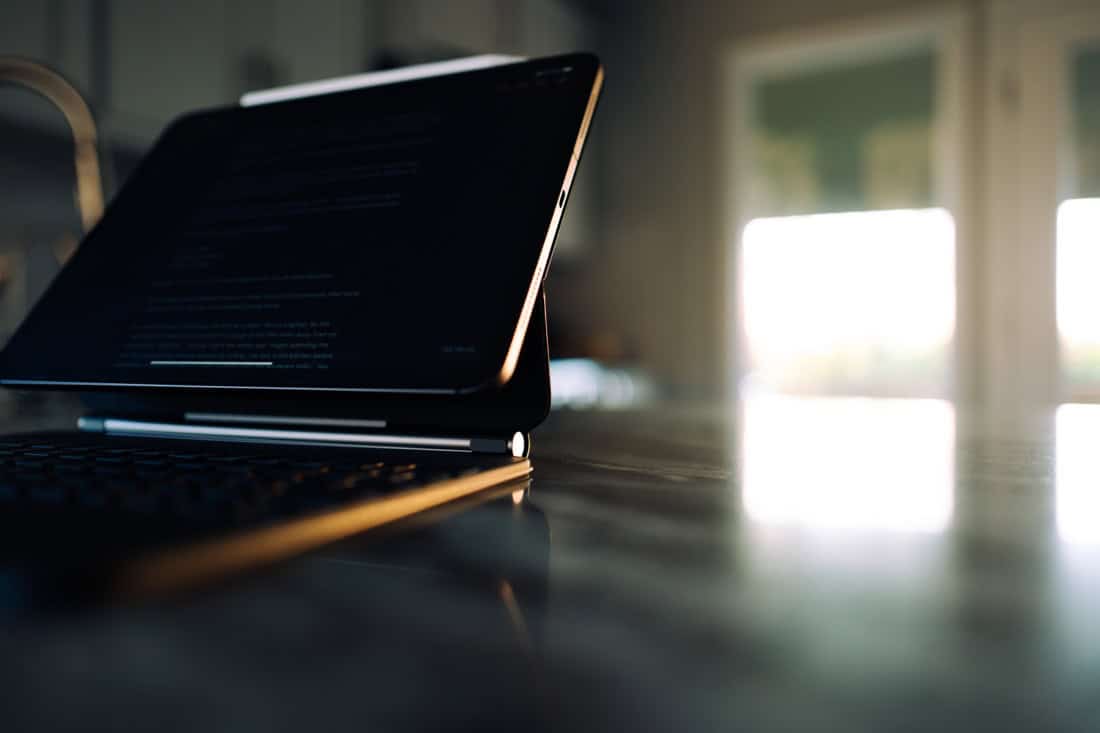
The 6am writing timeblock has been working well for me.
As I shared in my previous post, I have recently begun getting up around 6am to spend the first hour of my day writing in the kitchen with a cup of coffee, my iPad, and Ulysses.
By 7:15 all the boys are up, and so we have breakfast with the family.
Then, I head down to my home office around 8:30 to do more work. Followed by a workout before lunch. And then a few more hours of work before wrapping up around 4pm or so.
As I wrote a few weeks ago, this is a new writing routine for me that came out of my need to re-evaluate how I’ve been spending my work days.
I will admit that I fell out of this early morning writing routine a little bit last week because it was our sabbatical week. Last week I let myself sleep in that extra hour instead of getting up early to write, and I let myself stay up a bit later to do some woodworking in the garage — building a beautiful Quarantine Coffee Table that I will never forget.
But this morning… I was back at my early morning writing. And this time I had a new typing tool at my fingertips!
My iPad Magic keyboard arrived late last week.
On Thursday evening, to be exact. While I was out with my boys to get curbside pickup of BBQ from our favorite spot: Joe’s KC.
(Let’s just say that when we got back with our BBQ dinner ready to eat and I discovered an iPad Magic Keyboard sitting on the front porch ready to be unboxed… it was a dilemma. But I was hungry and so I was somehow able to let the keyboard wait until after the boys had gone to bed.)
Anyway…
Long-time readers of this website may be all-too familiar with some of my previous in-depth, winded, opinionated, articles about keyboards.
I love a good keyboard. And I love my iPad.
So you’d think that if Apple came out with an amazing keyboard for the iPad, it’d be my New Favorite Thing.
Well. I’m not entirely sure if it is my New Favorite Thing or not.
I’ve read the Magic Keyboard reviews. Watched the videos. And I have loved reading everyone’s opinion about this thing, because it’s a HUGE step forward for Apple (and the iPad) on many, many levels.
In 2018 we got the epic reinvention of the iPad Pro, followed by iPadOS in 2019, followed by amazing trackpad support last month, followed by this Magic Keyboard…
Apple is saying over and over again that the iPad has a bright, professional, awesome future.
But as for me and this Magic Keyboard…
I’m still not sure if I like it. Or, at least, I’m not sure how much I like it for day to day use around my house an in my home office.
But don’t read into things too much. Really. I’m 50/50 on this… it’s too early to tell.
Because I also have to say that now that I’ve been using the Magic Keyboard for several days I’m not sure I could go back to that Smart Keyboard Folio.
Today I spent just about my entire workday working from just the iPad and the Magic Keyboard. (Usually I spend about half my day on the iMac and half my day with the iPad.)
And the typing experience on the Magic Keyboard is far superior to that of the Smart Keyboard. I mean, of course it is. This is a real keyboard. With backlights. And it’s not some plastic-wrapped thingamajig. But with my 11-inch iPad, the keyboard does feel more cramped. I have typos galore, and I am having a hard time adjusting to the way that the iPad itself sort-of blocks access to the top row of number keys.
And the trackpad. This. This thing is quikly becoming so nice and useful and something I may never be able to go back to even though it is still early adoption within iPadOS and many of the apps. (Things 3 in particular really shines with it’s keyboard and trackpad support.)
I know there are many more iPad apps that will be supporting trackpad and keyboard support. And I bet we’re going to see an increase in professional-grade apps as well. So that’s another way this keyboard will be improving the iPad experience.
Down the road when our lives begin to return to some sort of normal, and travel is something that we can do again, the iPad Magic Keyboard will be the ideal travel accessory for the iPad Pro.
But for now, it’s stuck with me here at home. And I have more thoughts and specifics that I may get into later about exactly how this Magic Keyboard works for me at home.
But! At the very least, this keyboard will be my new 6am writing companion.
And if it can help me write and create more on a daily basis then that is a huge win.
6am Writing
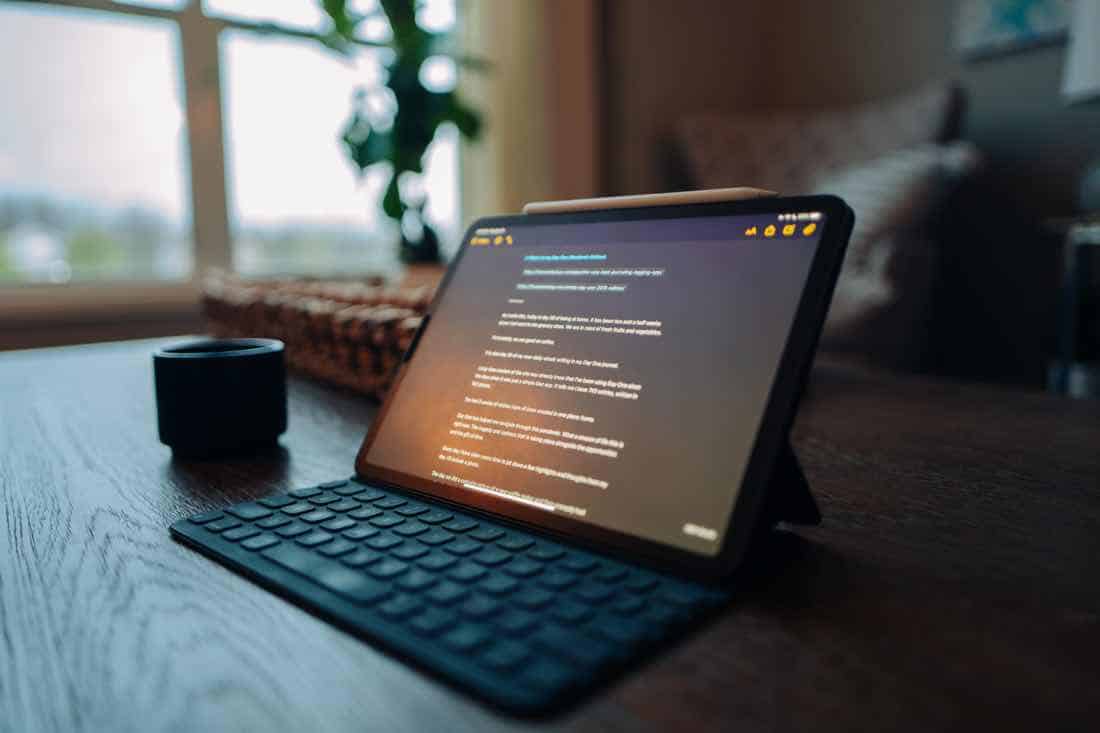
This past week I have been trying something new in the mornings.
We have 3 boys at home. And if I ever write a book on parenting it will have one chapter. And in that one chapter it will have one sentence. And the one sentence would be this:
“Buy an OK-To-Wake Clock.”
That’s it. That’d be the whole parenting book.
So this week, as I said, I have been trying something new.
I still wake up a little after 6am, which is when I normally wake up anyway. And that means I get an entire hour to myself before the boys wake up. (Thanks to their ok-to-wake clocks, they all stay in their rooms, quiet, until 7:15am. Every single day. (I know, right!?))
And I have been spending the first quiet hour of my day writing.
I wake up. Put on sweats. Make a cup of coffee. Sit down at the kitchen counter. And write for 30 or 45 minutes.
I’m here right now. The house is quiet. The sun is just beginning to rise. And there is the dim early morning light warming up the windows. And I am writing.
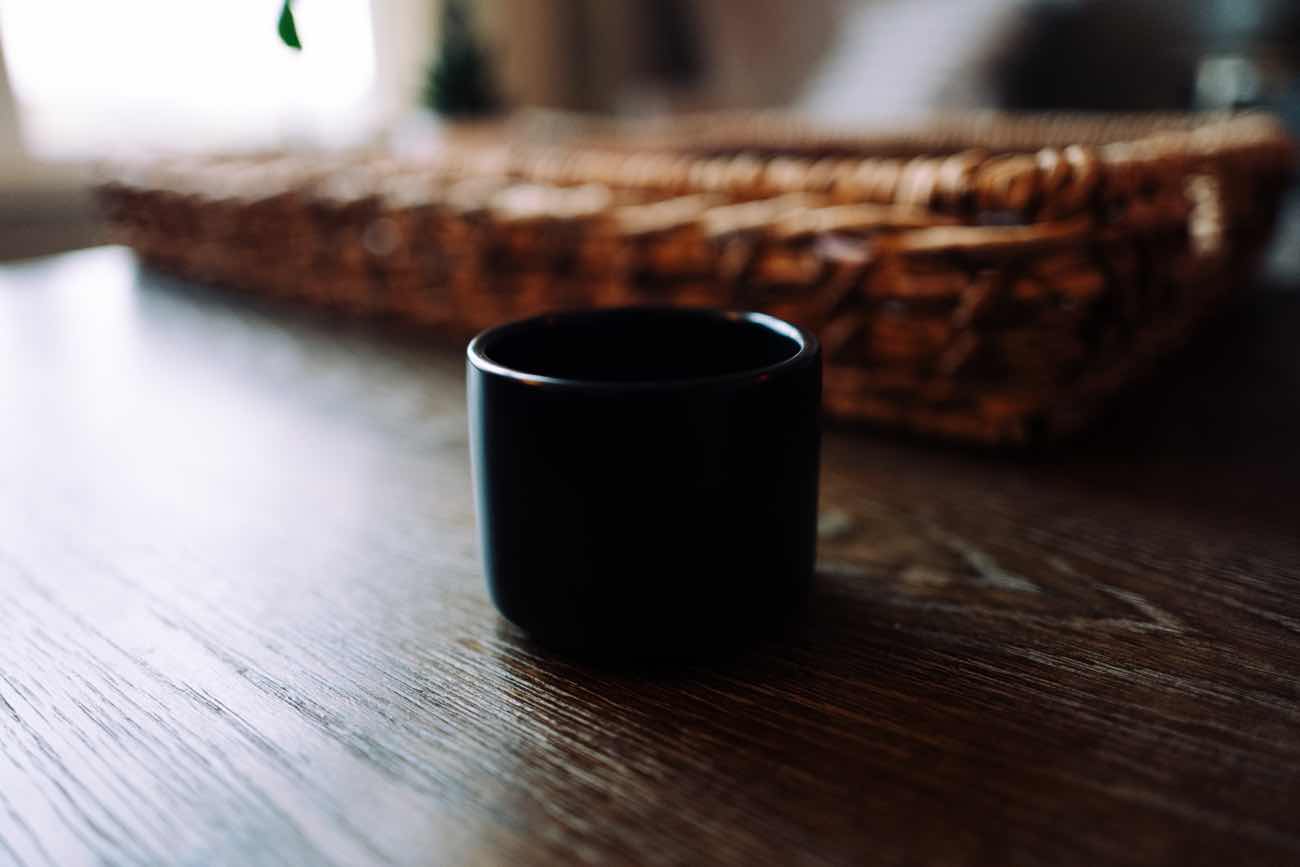
During the past month, I’d been noticing that I was struggling with my morning writing time. There are not one but two articles I am supposed to have already written for The Sweet Setup that are still in my drafts folder. And so I knew something needed to change.
During my work day, I have been more distracted — doing more busywork — than normal. I had to create a separate task list that is just all the “busywork ideas” I have. It’s a list of the little things I suddenly want to do around my house and around my office now that I am just here all day every day. And they’re all good things to do, but they also are distractions from what I need to be doing. (Writing it down on its own list helps me to stay focused.)
So, in order to combat my newfound work-from-home distractions, I’m trying a new writing routine to help me be more focused on this single most important task of the day.
Of course, all the “distraction talk” is not to say that my whole day has gone to the birds.
We Blancs are on day 35 of life and work and school from home. We certainly have our good days and our bad days. And in the midst of everything — the inside monotony and outside pressures of life — our routines have become all the more important.
A few things I have stayed vigilant with are:
- Protecting my time to rest and think during my day.
-
Using routines and systems to make things easier on myself.
In another article I’ll have to write up the nitty gritty things of my routines and systems that have helped keep my day on track.
But first I want to share a “bigger idea”. Which is the simple idea of having big chunks of your day blocked out.
Here. Check this out.
It’s a copy of Benjamin Franklin’s daily schedule.
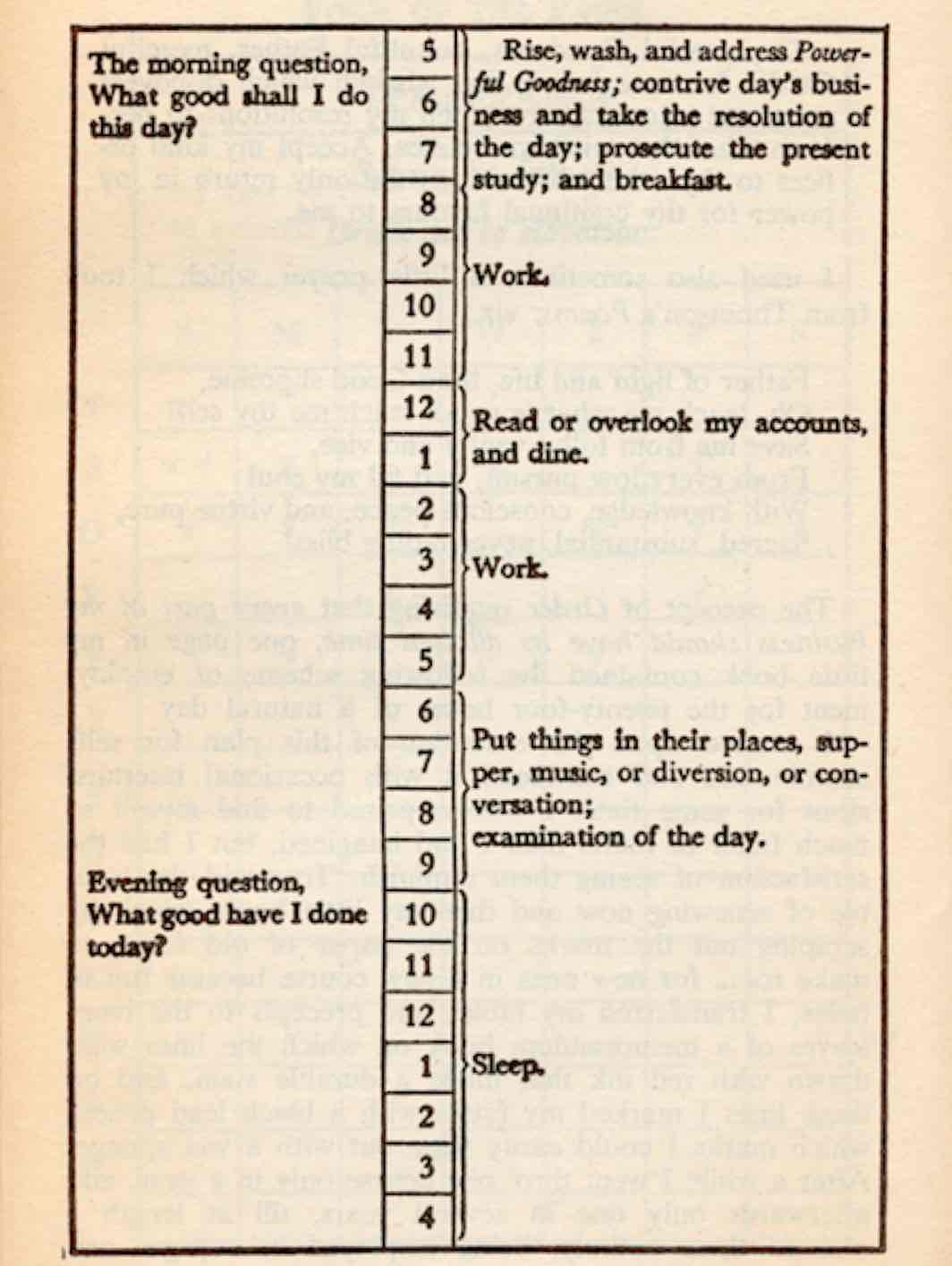
This simple schedule of Benjamin Franklin’s has been an inspiration to me for years!
What I like is how open and simple it is. (And how he had “diversions” as part of his daily routine.)
If you look at it, you’ll see that he had only 6 blocks of time scheduled each day:
- Morning Routine: 3 hours for getting ready, shower, breakfast, personal study, and prepare for work
- Work: 4 hours
- Afternoon break: 2 hours for eating, reading, and admin
- Work: 4 hours
- Evening Routine: 4 hours for dinner, relaxing, diversions, and wrapping up the day
- Sleep: 7 hours
This, dear reader, is timeblocking. And it’s marvelously effective.
For my day, I have big “blocks” like what you see on Benjamin Franklin’s schedule. And I also will time block within those . . . mapping my day’s most important tasks to a time on my calendar.
Having a simple way to schedule your day can be especially important if you find yourself in the middle of a transition — such as trying to figure out how to work from home with additional distractions you wouldn’t have at the office.
Timeblocking can help you regain control of your day and make sure you are spending your time effectively on the things that are important.
I regularly come back to my own daily schedule to re-evaluate it and see if it is serving me as well as it should be.
Hence, this week’s early-morning writing experiment. I simply shifted around two blocks of time to see if it would improve my day. And it has!
Now, I don’t know if this is early wake and write will be my new normal. But it’s working right now and that is what matters.
Ulysses for iPad Now Has Split-Screen Editing →
On Monday I officially ran out of feature ideas and improvements for Ulysses. Because the iPad app now offers split-screen editing, and it’s fantastic.
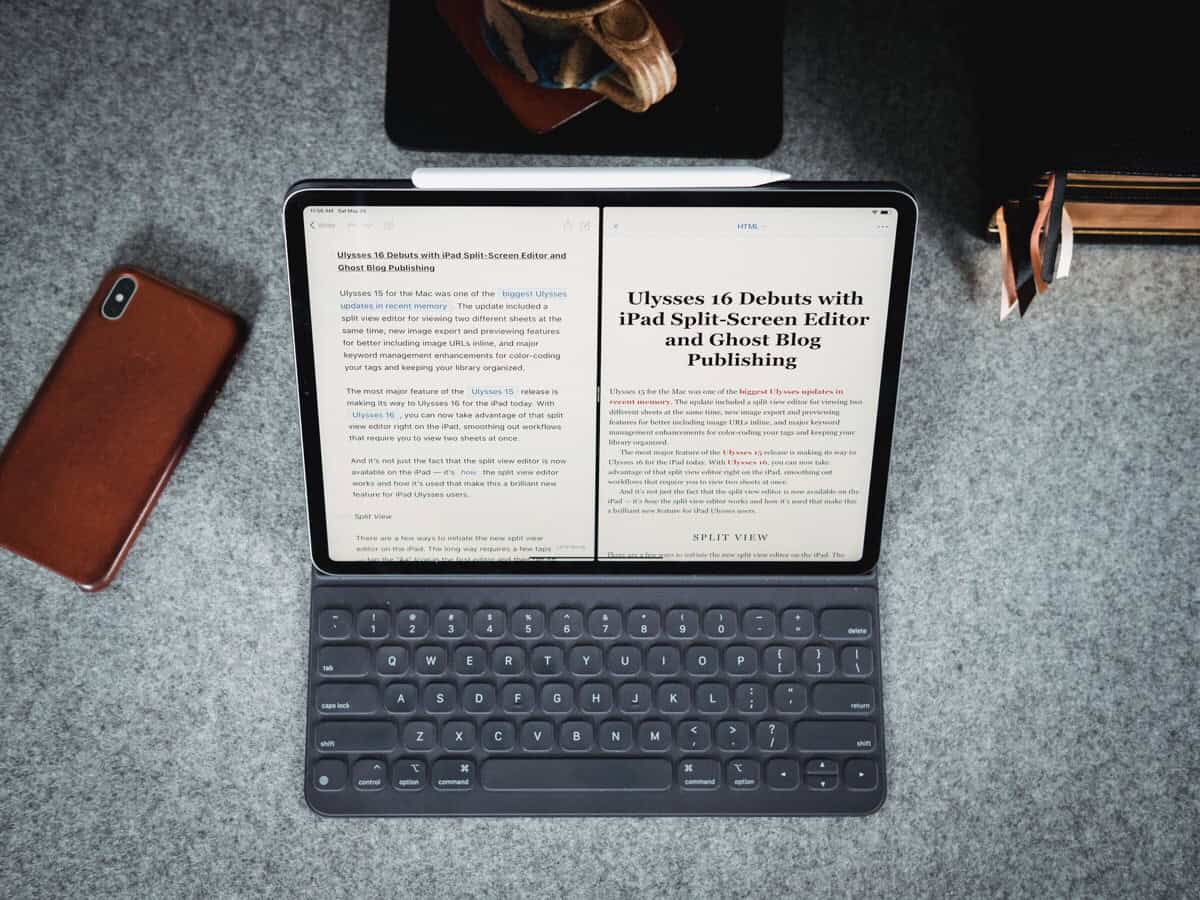
I mostly use Ulysses from my iPad, and this was the last remaining feature request for me.
I don’t need a split screen editor all the time, but it is something that I often incorporate as part of my writing workflow. Usually I will have an outline on one side and my working draft on the other.
Before Ulysses offered split-screen edition on the Mac version, I had a Keyboard Maestro macro that would open up a new editing window and re-size. On the iPad, if I wanted to do side-by-side document work, I would usually copy all the text from my outline out of ULysses and put it into Bear so I could work with those two apps in split view (since iOS supports it, but Ulysses did not).
The way that they’ve implemented split view in Ulysses is just perfect. There are lots of little nuances in it to make it delightful, and it feels just perfect on the iPad. It’s an excellent example of an iOS app feature done right.
And it’s power-user friendly, too, of course. You can use the keyboard to enable the second editor and switch between which document is in focus. Or you can drag a document out of your library and over to the “side” to open that document in the second editor.
(This is one feature that now makes me wish ever-so-slightly that I would have held on to the 12.9-inch iPad Pro instead of trading it in for the 11-inch.)
On the Sweet Setup, we put together a review of this newest version of Ulysses that also walks you through exactly how the new split-screen editor works and how you can use it.
(And, of course, if you’re a Ulysses user — or want to be — we have a pretty fantastic series of training videos for you.)